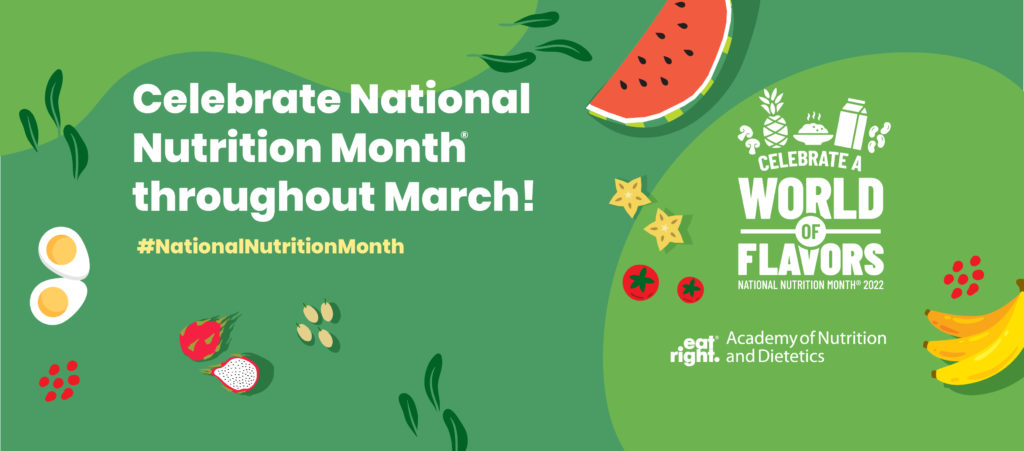
National Nutrition Month (NNM) is an annual campaign of the Academy of Nutrition and Dietetics. Even though as a dietitian I focus on food and healthy eating all year long, it’s nice to give extra attention to specific nutrition topics every March, for instance, here’s last year’s NNM post.
This year’s NNM theme is Celebrate a World of Flavors. I think this is a great theme for a few reasons. One, I like to celebrate things, and the idea of celebrating food is appealing to me. Two, it includes all cultures and their foods. And three, it reinforces the cultural foods messages of MyPlate—that it’s possible to plan healthy meals that include traditional or heritage foods. Here are my tips for bringing a healthy celebration of world flavors to your own table.
Try something new
Getting into a food rut where you’re cooking the same things on repeat (or eating the same fruits and veggies every week) is a recipe for boredom. In addition, eating a wider variety of foods means your body will get a wider array of nutrients. That means not only a variety of vitamins and minerals, but also different types of fiber, and health-promoting phytonutrients.
Here’s some ideas to embrace food variety. First, work on getting out of a food rut. Second, challenge yourself to purchase some new foods (maybe one new thing a week) and experiment with it. And lastly, find some new recipes and give them a try. Check out the recipes on the Guiding Stars website (many are inspired by other cultures). Eating at local restaurants and trying new international cuisines when traveling (look to sample foods at community events closer to home) are great ways to find new foods and dishes you like.
Create a global pantry (and fridge)
It’s a whole lot easier to create interesting meals comprised of dishes from around the world if you keep some of the ingredients on hand. Don’t worry—you don’t have to break the bank or waste food by purchasing things you’ll only use once or twice! Many cuisines rely on certain staple ingredients that are relatively easy to find in your store. As always, look for Guiding Stars to help you choose nutritious items. Consider stocking some of these commonly used ingredients:
- Dry grains: rice varieties, barley, bulgur, oatmeal, freekah, wheatberries, quinoa
- Lentils, dried beans & peas: split peas, various colors of lentils, bags of dried beans/bean mixes
- Canned vegetables & beans: chickpeas, black beans, canned tomato products, canned soybeans, pumpkin
- Condiments: soy sauce (consider lower sodium soy sauce), fish sauce, Worcestershire sauce, wholegrain mustard, ketchup, salsa, bottled mojo criollo
- Canned/pouches of fish: tuna, sardines, salmon
- Cooking oils: olive oil, sesame oil, avocado oil
- Nuts, seeds & dried fruit: almonds, walnuts, mixed nuts, sesame seeds, chia seeds, pepitas, raisins/currants, dried apricots, prunes
- Flours: white, whole wheat, chickpea, almond, coconut (typically, you can store flours in the freezer to extend their shelf life)
- Flavorings: concentrated stock paste or cubes (chicken, beef, vegetable), boxed broths, coconut milk, various vinegars, mirin, cocoa powder, garlic bulbs
- Spices: allspice, basil, bay leaves, cayenne pepper, celery seed, chili powder, cinnamon, cloves, coriander, curry powder, dill, fennel, garam masala, garlic powder/salt, nutmeg, onion powder, oregano, pepper, paprika/smoked paprika, poppy seeds, red pepper flakes, rosemary, various types of salts, sage, sazon, thyme, turmeric, z’atar
How do I fit cultural foods into MyPlate?
Both MyPlate and this year’s NNM theme recognize that our population is a beautiful mix of cultures. As such, we cook and eat a wide variety of dishes and foods reflect heritage, culture, and tradition. Guidance for how to incorporate cultural foods into the healthy MyPlate framework is provided throughout the MyPlate website. For example, the food lists include a wider variety of fruits, vegetables, grains, and vegetarian protein sources than ever before. This makes putting together a healthy plate easier to plan. You can find many culturally traditional foods at your supermarket. Guiding Stars can help you compare foods and select options that provide more nutrition.
When incorporating traditional recipes into MyPlate, adjustments may be needed to certain ingredients. For instance, a dish may call for a larger portion of rice than is recommended by MyPlate guidelines. If you’re not sure how to adjust a recipe to fit MyPlate, you may have luck in finding a similar recipe among the large collection provided in MyPlate Kitchen. Many MyPlate recipes are inspired by traditional dishes from a variety of cultures (there are videos for some of them). You can also search the recipe database by cuisine, such as Latin American, Native American, Mediterranean, Middle Eastern, and Asian.
In honor of National Nutrition Month, I hope you’ll try to Celebrate a World of Flavors wherever you eat. It’s big wide food world out there, why not enjoy it?